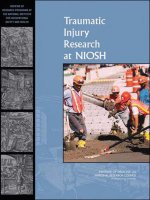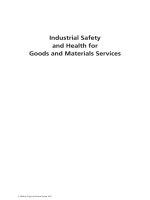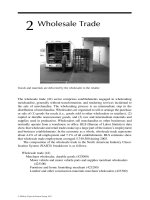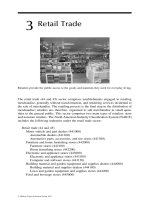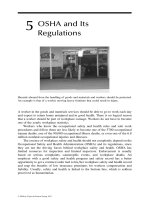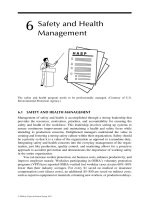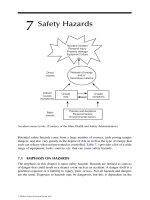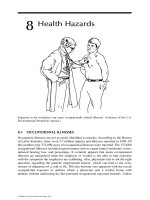industrial safety and health for people-oriented services
Bạn đang xem bản rút gọn của tài liệu. Xem và tải ngay bản đầy đủ của tài liệu tại đây (5.12 MB, 476 trang )
Industrial Safety
and Health for
People-Oriented Services
Reese/Industrial Safety and Health for People-Oriented Services 53841_C000 Final Proof page i 9.9.2008 7:48pm Compositor Name: BMani
Handbook of Safety and Health for the Service Industry
Industrial Safety and Health for Goods and Materials Services
Industrial Safety and Health for Infrastructure Services
Industrial Safety and Health for Administrative Services
Industrial Safety and Health for People-Oriented Services
Reese/Industrial Safety and Health for People-Oriented Services 53841_C000 Final Proof page ii 9.9.2008 7:48pm Compositor Name: BMani
HANDBOOK OF
SAFETY AND HEALTH FOR THE SERVICE INDUSTRY
Industrial Safety
and Health for
People-Oriented Services
Charles D. Reese
Reese/Industrial Safety and Health for People-Oriented Services 53841_C000 Final Proof page iii 9.9.2008 7:48pm Compositor Name: BMani
CRC Press
Taylor & Francis Group
6000 Broken Sound Parkway NW, Suite 300
Boca Raton, FL 33487-2742
© 2009 by Taylor & Francis Group, LLC
CRC Press is an imprint of Taylor & Francis Group, an Informa business
No claim to original U.S. Government works
Printed in the United States of America on acid-free paper
10 9 8 7 6 5 4 3 2 1
International Standard Book Number-13: 978-1-4200-5384-5 (Hardcover)
This book contains information obtained from authentic and highly regarded sources. Reasonable
efforts have been made to publish reliable data and information, but the author and publisher can-
not assume responsibility for the validity of all materials or the consequences of their use. The
authors and publishers have attempted to trace the copyright holders of all material reproduced
in this publication and apologize to copyright holders if permission to publish in this form has not
been obtained. If any copyright material has not been acknowledged please write and let us know so
we may rectify in any future reprint.
Except as permitted under U.S. Copyright Law, no part of this book may be reprinted, reproduced,
transmitted, or utilized in any form by any electronic, mechanical, or other means, now known or
hereafter invented, including photocopying, microfilming, and recording, or in any information
storage or retrieval system, without written permission from the publishers.
For permission to photocopy or use material electronically from this work, please access www.copy-
right.com ( or contact the Copyright Clearance Center, Inc. (CCC), 222
Rosewood Drive, Danvers, MA 01923, 978-750-8400. CCC is a not-for-profit organization that pro-
vides licenses and registration for a variety of users. For organizations that have been granted a
photocopy license by the CCC, a separate system of payment has been arranged.
Trademark Notice: Product or corporate names may be trademarks or registered trademarks, and
are used only for identification and explanation without intent to infringe.
Library of Congress Cataloging-in-Publication Data
Reese, Charles D.
Industrial safety and health for people-oriented services / Charles D. Reese.
p. cm.
Includes bibliographical references and index.
ISBN 978-1-4200-5384-5 (alk. paper)
1. Service industries United States Safety measures. 2. Service
industries Employees Health and hygiene United States. 3. Human
services United States Employees. I. Title.
HD7269.S452U6744 2009 658.3’82 dc22
Visit the Taylor & Francis Web site at
and the CRC Press Web site at
Reese/Industrial Safety and Health for People-Oriented Services 53841_C000 Final Proof page iv 9.9.2008 7:48pm Compositor Name: BMani
Contents
Preface xxi
Author xxiii
Chapter 1 Introduction to the Service Industry 1
1.1 NAICS 2
1.2 Employment in the Service Industry 2
1.3 Safety 3
1.4 Why Trauma Prevention? 5
1.5 Accidents or Incidents 5
1.6 Comprehensive Accident Prevention 6
1.7 Fatality and Injury Profile for the Service Industry 7
1.8 Occupational Illnesses in the Service Industry 10
References 11
Chapter 2 Educational Services 13
2.1 Educational Services 14
2.2 Profile of Educational Service Workers’ Deaths, Injuries, and Illnesses 16
2.2.1 Deaths 16
2.2.2 Injuries 16
2.2.3 Illnesses 16
2.3 Hazards Faced by Educational Services Workers 16
2.4 Occupations 19
2.5 Applicable OSHA Regulations 21
References 22
Chapter 3 Health Care and Social Assistance 23
3.1 Health Care 24
3.2 Social Assistance 26
3.3 Profile of Health Care and Social Assistance Workers’ Deaths,
Injuries, and Illnesses 27
3.3.1 Deaths 27
3.3.2 Injuries 27
3.3.3 Illnesses 27
3.4 Hazards Faced by Health and Social Care Service Workers 30
3.5 Occupations 30
3.5.1 Health Care Services 30
3.5.2 Social Assistance 32
Reese/Industrial Safety and Health for People-Oriented Services 53841_C000 Final Proof page v 9.9.2008 7:48pm Compositor Name: BMani
v
3.6 Applicable OSHA Regulations 33
3.6.1 Health and Social Care Services 34
References 35
Chapter 4 Leisure and Hospitality Sectors 37
4.1 Arts, Entertainment, and Recreation 38
4.1.1 Live Performances or Events 38
4.1.2 Historical, Cultural, or Educational Exh ibits 39
4.1.3 Recreation or Leisure Activities 39
4.1.4 Work Conditions 40
4.2 Profile of Arts, Entertainment, and Recreation Workers’
Deaths, Injuries, and Illnesses 41
4.2.1 Deaths 41
4.2.2 Injuries 42
4.2.3 Illnesses 42
4.3 Hazards Faced by Arts, Entertainment, and Recreation Workers 44
4.4 Occupations 45
4.5 Applicable OSHA Regulations 49
Reference 50
Chapter 5 Accommodation and Food Services 51
5.1 Hotels and Other Accommodations 52
5.2 Food Se rvices and Drinking Places 55
5.3 Profile of Accommodation and Food Services Workers’ Deaths,
Injuries, and Illnesses 57
5.3.1 Deaths 57
5.3.2 Injuries 57
5.3.3 Illnesses 58
5.4 Occupations 58
5.4.1 Hotels and Other Accommodations 58
5.4.2 Food Se rvices and Drinking Places 62
5.5 Applicable OSHA Regulations 64
Reference 66
Chapter 6 Other Services 67
6.1 Maintenance and Repair Workers—General 68
6.2 Building Cleaning Workers 70
6.3 Profile of Other Services Workers’ Deaths, Injuries, and Illnesses 72
6.3.1 Deaths 72
6.3.2 Injuries 72
6.3.3 Illnesses 74
Reese/Industrial Safety and Health for People-Oriented Services 53841_C000 Final Proof page vi 9.9.2008 7:48pm Compositor Name: BMani
vi
6.4 Hazards Faced by Other Services Workers 75
6.5 Occupations 76
6.6 Applicable OSHA Regulations 76
Reference 79
Chapter 7 Managing Safety and Health People Service Sectors 81
7.1 Principles of Management 82
7.2 Safety and Health Program 83
7.2.1 Reasons for Building a Safety and Health Program 85
7.2.2 Building a Safety and Health Program 86
7.2.3 Other Required Written Programs 86
7.2.4 OSHA Guidelines for a Safety and Health Program 87
7.2.5 Safety and Health Program Elements 88
7.3 Summary 92
Chapter 8 Summary of 29 CFR 1910 93
8.1 Part 1910—Occupational Safety and Health Standar ds 94
8.1.1 Subpart A—General 94
8.1.2 Subpart B—Adoption and Extension of Established
Federal Standards 94
8.1.3 Subpart C—[Removed and Reserved] 95
8.1.4 Subpart D—Walking–Working Surfaces 95
8.1.5 Subpart E—Exit Routes, Emergency Action Plans,
and Fire Prevention Plans 97
8.1.6 Subpart F—Powered Platforms, Manlifts,
and Vehicle-Mounted Work Platforms 98
8.1.7 Subpart G—Occupational Health and Environmental Control 99
8.1.8 Subpart H—Hazardous Materials 99
8.1.9 Subpart I—Personal Protective Equipment 101
8.1.10 Subpart J—General Environmental Controls 102
8.1.11 Subpart K—Medical and First Aid 103
8.1.12 Subpart L—Fire Protection 103
8.1.13 Subpart M—Compressed-Gas
and Compressed-Air Equipment 104
8.1.14 Subpart N—Materials Handling and Storage 105
8.1.15 Subpart O—Machinery and Machine Guarding 106
8.1.16 Subpart P—Hand and Portable Powered Tools
and Other Handheld Equipment 107
8.1.17 Subpart Q—Welding, Cutting, and Brazing 108
8.1.18 Subpart R—Sp ecial Industries 109
8.1.19 Subpart S—Electrical 110
8.1.20 Subpart T—Commercial Diving Operati ons 112
8.1.21 Subparts U–Y [Reserved] 113
8.1.22 Subpart Z—Tox ic and Hazardous Substances 113
Reese/Industrial Safety and Health for People-Oriented Services 53841_C000 Final Proof page vii 9.9.2008 7:48pm Compositor Name: BMani
vii
Chapter 9 Safety Hazards 115
9.1 Hazard Identification 115
9.2 Worksite Hazard Analysis 117
9.3 Training on Hazard Identification 117
9.4 Worksite Hazard Identification 118
9.5 Hazard Assessment Guide 119
9.5.1 Organize the Data 120
9.5.2 Analyze the Data 120
9.5.3 Selection of Con trols 120
9.5.4 Fitting the PPE 121
9.5.5 Reassessment of the Hazards 121
9.6 Controlling Hazards 122
9.6.1 Managing the Safety Controls 122
9.6.2 Technical Aspects of Hazard Control 123
9.7 Source Control 124
9.7.1 Elimination 124
9.7.2 Substitution 124
9.7.3 Redesign 124
9.7.4 Isolation 124
9.7.5 Automation 124
9.8 Control along the Path from the Hazard
to the Worker 124
9.8.1 Barriers 125
9.8.2 Absorption 125
9.8.3 Dilution 125
9.9 Control at the Level of the Worker 125
9.9.1 Administrative Controls 125
9.9.2 Work Procedures, Training, and Supervision 125
9.9.3 Emergency Planning 126
9.9.4 Housekeeping, Repair, and Maintenance Programs 126
9.9.5 Hygiene Practices and Facilities 126
9.9.6 Selecting Controls 126
9.10 Personal Protective Equipment 126
9.10.1 Eye and Face Protection 127
9.10.2 Head Protection 127
9.10.3 Foot Protection 127
9.10.4 Hand Protection 127
9.10.5 Upper=Lower Body Protection 128
9.10.6 Cleaning and Maintenance 128
9.11 Evaluating the Effectiveness of Controls 128
9.12 Summary 128
9.12.1 Job Safety Assessment 129
9.12.2 Controls 129
9.12.3 Accident Reporting 130
Reese/Industrial Safety and Health for People-Oriented Services 53841_C000 Final Proof page viii 9.9.2008 7:48pm Compositor Name: BMani
viii
9.12.4 Incident Reporting Procedures 131
9.12.5 Training 131
9.12.6 Program Audits 131
Chapter 10 Health Hazards 133
10.1 Identifying Health Hazards 134
10.1.1 Prepare a List of Known Health Hazards in the Workplace 134
10.1.2 Review Floor Plans and Work Process Diagrams 135
10.1.3 Interview Workers, Supervisors, and Managers 135
10.1.4 Use Your Five Senses 135
10.1.5 Quick Health Haza rd Identification Che cklist 135
10.1.6 Health Hazards Assessment 136
10.2 Chemical Hazards 136
10.3 Biological Hazards 136
10.4 Physical Health Hazards 137
10.4.1 Noise 138
10.4.2 Vibration 138
10.4.3 Heat and Cold 138
10.4.4 Radiation . 138
10.5 Ergonomic Hazards 139
10.5.1 Stress Hazards . 140
10.6 Summary 141
Chapter 11 Biological Safety 143
11.1 Biosafety Levels 143
11.1.1 Biosafety Level 1 143
11.1.2 Biosafety Level 2 144
11.1.3 Biosafety Level 3 144
11.1.4 Biosafety Level 4 144
11.2 Requirements of Biosafety Level 1 145
11.2.1 Standard Microbiological Practices for BSL-1 145
11.2.2 Safety Equipment for BSL-1 145
11.2.3 Facilities for BSL-1 145
11.3 Biosafety Level 2 Requirements 146
11.3.1 Standard Microbiological Practices for BSL-2 146
11.3.2 Special Practices for BSL-2 147
11.3.3 Safety Equipment for BSL-2 148
11.3.4 Facilities (Secondary Barriers) for BSL-2 149
11.4 Biological Spills 149
11.4.1 Decontamination of Spills 151
11.4.2 Biological Spill on a Person 152
11.5 Infectious Waste Management 152
11.5.1 Separation and Packaging of Infectious Waste 152
11.5.2 Storage and Transport of Infectious Waste 153
Reese/Industrial Safety and Health for People-Oriented Services 53841_C000 Final Proof page ix 9.9.2008 7:48pm Compositor Name: BMani
ix
11.5.3 Infectious Waste Treatment 153
11.5.4 Steam Sterilization 153
11.5.5 Incineration 153
11.5.6 Chemical Disinfection 153
11.6 Bloodborne Pathogens 154
Chapter 12 Chemical Safety 159
12.1 Hazardous Chemicals 159
12.1.1 Ignitability 160
12.1.2 Corrosivity 160
12.1.3 Reactivity 160
12.2 Definition of a Hazardous Chemical 161
12.2.1 Health Hazard 161
12.2.2 Physical Hazard 161
12.2.3 Additional Hazardous Chemicals 161
12.3 Chemical Hazards 161
12.4 Toxic Effects 162
12.4.1 Other Types of Toxins 163
12.4.2 Carcinogens 163
12.5 Working with Toxins 169
12.5.1 Guidelines for Using Toxins 170
12.5.2 Guidelines for Using Acute Toxins 171
12.5.3 Guidelines for Using Chronic Chemicals, Carcinogens,
and Reproductive Toxins 172
12.6 Storing Hazardous Chemicals 173
12.6.1 Storage Facilities 173
12.6.2 Inspection of Stored Chemicals 174
12.6.3 Refrigerator Storage 175
12.7 Transportation of Hazardous Chemicals 175
12.7.1 Use Secondary Containers 175
12.8 Chemical Waste Management 175
12.8.1 Storage 176
12.8.2 Waste Minimization 176
12.9 Hazardous Chemical Emergency Procedures 176
12.9.1 Procedures for Spills of Volatile, Toxic,
or Flammable Mate rials 176
12.9.2 Incidental Spills 177
12.9.3 Major Spills 178
12.10 Worker Contamination 178
12.10.1 Chemical Spill on a Worker 178
12.10.2 Procedure for Cryogenic Liquid Spill on a Person 179
12.11 Chemicals and Worker Health 179
12.11.1 Medical Surveillance 179
12.11.2 Medical Consultation and Evaluation 180
Reese/Industrial Safety and Health for People-Oriented Services 53841_C000 Final Proof page x 9.9.2008 7:48pm Compositor Name: BMani
x
Chapter 13 Preventing Musculoskeletal Disorders 183
13.1 Musculoskeletal Disorders 183
13.2 Organized Approach 184
13.2.1 Provide Management Support 184
13.2.2 Involve Employees 185
13.2.3 Identify Problems 185
13.2.4 Implement Solutions 187
13.3 Back and Back Injuries 190
13.3.1 Factors Associated with Back Disorders 191
13.3.2 Types of Injuries from Lifting Tasks 192
13.3.3 Inherent Hazards 193
13.4 Prevention and Control 193
13.4.1 Engineering Controls 193
13.4.2 Work Practices 194
13.4.3 Adjustment to Work 194
13.4.4 Other Solutions 195
13.5 Summary 197
13.5.1 Lifting 197
Chapter 14 Electrical Safety 199
14.1 Electrical Dangers 199
14.2 Electrical Pathways 200
14.3 Result of Electr ical Contact 200
14.4 Voltage 201
14.5 Current 202
14.6 Electrical Burns 203
14.6.1 Voltage Burns 203
14.6.2 Arcing Burns 204
14.6.3 Thermal Burns 204
14.7 Handling Electrical Hazards 204
14.7.1 Identify Hazards 204
14.7.2 Evaluate Hazards . 204
14.7.3 Control Hazards 204
14.8 Identifying Hazards 205
14.9 Specific Hazards 206
14.9.1 Inadequate Wiring Hazards 206
14.9.2 Exposed Electrical Parts Hazards 206
14.9.3 Overhead Power Line Hazards 206
14.9.4 Defective Insulation Hazards 207
14.9.5 Improper Grounding Hazards 207
14.9.6 Ground Fault Circuit Interrupter 208
14.9.7 Overload Hazards 208
14.9.8 Wet Conditions Hazards 209
Reese/Industrial Safety and Health for People-Oriented Services 53841_C000 Final Proof page xi 9.9.2008 7:48pm Compositor Name: BMani
xi
14.10 Safe Use of Electrical Power Tools 209
14.11 Safe Use of Power Cords 210
14.12 Applicable OSHA Regulations 210
14.12.1 Electrical (29 CFR 1910.303, .304, .305, .331, and .333) 210
14.13 Summary 212
Chapter 15 Emergency and Fire Safety 215
15.1 Emergency Action Plans 216
15.1.1 Chain of Command 217
15.1.2 Emergency Response Teams 217
15.1.3 Response Activities 218
15.1.4 Training 218
15.1.5 Personal Protection 219
15.1.6 Medical Assistance 219
15.2 Exits and Exit Routes 219
15.2.1 Requirements for Exits 220
15.2.2 Safety Features for Exit Routes 220
15.2.3 Design and Construction Requirements 221
15.3 Fire Prevention Plans 221
15.4 Portable Fire Suppression Equipment 222
15.4.1 Scope, Application, and Definitions—1910.155 222
15.4.2 Fire Brigades—1910.156 223
15.4.3 Portable Fire Extinguishers—1910.157 224
15.4.4 Standpipe and Hose Systems—1910.158 225
15.4.5 Fixed Fire Suppression Equ ipment—1910.159 227
15.4.6 Fixed Extinguishing Systems, General — 1910.160 227
15.4.7 Fixed Extinguishing Systems, Dry Chemical—1910.161 228
15.4.8 Fixed Extinguishing Systems, Gaseous Agent—1910.162 228
15.4.9 Fixed Extinguishing Systems, Water Spray
and Foam—1910.163 229
15.4.10 Fire Detection Systems—1910.164 229
15.4.11 Employee Alarm Systems—1910.165 229
15.5 Fire Protection Summary 230
15.6 Fire Protection Techniques 231
15.6.1 Flammable and Combustible Liquids 231
15.6.2 Electricity 232
15.6.3 Housekeeping 232
15.6.4 Hot Work 232
15.6.5 Checklist 233
Chapter 16 Hot Processes 235
16.1 Physiology of Hot Processes 236
16.1.1 Safety Problems 237
16.1.2 Health Problems 237
Reese/Industrial Safety and Health for People-Oriented Services 53841_C000 Final Proof page xii 9.9.2008 7:48pm Compositor Name: BMani
xii
16.2 Physical Effects of Hot Processes 239
16.2.1 General Hazards 239
16.2.2 Identifying Burn Hazards 240
16.3 Prevention of Hot Process Accidents 241
16.3.1 Lessening Hot Process Conditions 242
16.3.2 Controlling Thermal Conditions 243
16.3.3 Protective Clothing 243
16.3.4 Special Considerations 244
16.3.5 Protection against Hazards 244
16.3.6 Safety Practices and Procedures 246
16.4 Hot Processes in the Service Industry 248
16.5 Summary of OSHA Regulations 248
16.6 Checklist for Hot Processes 249
16.7 Summary 250
Chapter 17 Ionizing Radiation 251
17.1 Ionizing Radiation 251
17.2 Types of Radiation 253
17.2.1 Alpha Particles . 253
17.2.2 Beta Particles 254
17.2.3 Gamma Rays=X-Rays 255
17.2.4 Neutron Particles 256
17.3 Sources of Radiation 257
17.3.1 Natural Radiation 257
17.3.2 Man-Made Radiation 257
17.3.3 Sources of Exposure 257
17.4 Preventing Exposures from Ionizing Radiation 258
17.4.1 Exposure and Dose 259
17.4.2 External Radiation Protection 260
17.4.3 Internal Exposure Protection 261
17.4.4 Preventive Steps 262
17.5 Human Exposure Out comes 262
17.5.1 Health Effects of Radiation Exposure 262
17.5.2 Results of Exposure 263
17.5.3 Chronic Exposure 263
17.5.4 Acute Exposure 263
17.5.5 Risks of Health Effects 265
17.5.6 Personal Monitoring 266
17.6 Training 267
17.7 Radiation Areas 268
17.8 Specific Emergency Procedures 270
17.9 Summary of Applicable Regulations 271
17.9.1 Summary 271
Reese/Industrial Safety and Health for People-Oriented Services 53841_C000 Final Proof page xiii 9.9.2008 7:48pm Compositor Name: BMani
xiii
Chapter 18 Machine=Equipment Safeguarding 273
18.1 Machine=Equipment Safeguarding 273
18.2 Principles for Machine Guarding 273
18.3 Conducting an Assessment 274
18.4 Guidance on Assessing Machine=Equipment Safeguards 275
18.4.1 Assessing Safeguarding Risks 275
18.4.2 Evaluating Effectiveness of Safeguards 275
18.4.3 Assessing Management of Safeguards 277
18.4.4 Further Machine-Related Issues 277
18.4.5 Control and Machines 278
18.4.6 Operator Training 278
18.5 Typical Machines=Equipment Requiring
Safeguards 279
18.6 Safeguards 280
18.7 Areas to be Safeguarded 280
18.7.1 Danger Point or Zone 281
18.7.2 Point of Operation 281
18.7.3 Power Transmission Device 281
18.7.4 Lockout 282
18.8 Types of Safeguards 282
18.8.1 Barrier Guards 282
18.8.2 Redundant Safeguards 282
18.9 Controls and Control Systems 283
18.10 Control System Function 283
18.11 Types of Control Devices 283
18.11.1 Presence-Sensing Devices 284
18.11.2 Two-Hand Control Devices 284
18.11.3 Brake Monitor 285
18.11.4 Restraint=Pull Back Device 285
18.11.5 Location=Distance 286
18.12 Training 286
18.13 Maintenance 286
18.14 Enforcement 286
18.15 Periodic Review 286
18.16 Applicable OSHA Regulations 287
18.16.1 Machine Guarding (29 CFR 1910.212 and 219) 287
18.16.2 Mechanical Power Presses (29 CFR 1910.217) 288
18.16.3 Power Transmission Equipment Guarding
(29 CFR 1910.219) 288
18.17 Summary 289
Reese/Industrial Safety and Health for People-Oriented Services 53841_C000 Final Proof page xiv 9.9.2008 7:48pm Compositor Name: BMani
xiv
Chapter 19 Nonionizing Radiation 291
19.1 Nonionizing Radiation 291
19.1.1 Understanding and Evaluating Nonionizing
Radiation Hazards 292
19.1.2 Biological Effects 293
19.1.3 Other Areas of Concern with NIR 293
19.1.4 Personal Protection for NIR 295
19.2 Visible Light Radiation 295
19.3 Lasers 296
19.3.1 Laser Health Issues 299
19.3.2 Laser Protective Equ ipment 300
19.3.3 Laser Radiation 302
19.4 Noncoherent Light Source Safety 303
19.5 Ultraviolet Radiation 303
19.5.1 Ultraviolet Skin Hazards 304
19.5.2 Ultraviolet Eye Hazards 305
19.6 Infrared Radiation 305
19.6.1 Infrared Radiation Hazards 305
19.7 Microwave and Radiofrequency Radiation Safety 306
19.7.1 Microwave=RF Radiation Sources 306
19.7.2 Factors Affecting Exposure to Microwave=RF Radiation 306
19.7.3 Potential Biological Effects of Exposure
to Microwave=RF Radiation 307
19.7.4 Standards for Microwave=RF Radiation
Exposure Protection 307
19.7.5 Antennas and Antenna Arrays 307
19.7.6 Wireless Local Area Networks 307
19.7.7 Other Potential Microwave=RF Radiation Sources
(Leakage Sources) 307
19.7.8 Microwave Ovens 308
19.7.9 Power Supplies 309
19.8 Extremely Low-Frequency Radiation Safety 309
19.8.1 ELF Radiation 309
19.8.2 ELF Potential Human Health Hazards 309
19.8.3 Protection Standards for ELF Exposure 310
19.8.4 Normal ELF Field 310
19.9 Static Magnetic Field Safety 310
19.9.1 Factors Affecting Static Magnetic Field Hazards 310
19.9.2 Biological Effects of Exposure to Static Magnetic Fields 311
19.9.3 Kinetic Energy Hazards 311
19.9.4 Standards for Exposure to Static Magnetic Fields 311
19.9.5 Magnetic Field Measurements 311
19.9.6 Posting of Magnetic Field Hazards 312
19.9.7 Access Restrictions 312
19.9.8 Use of NIR Hazard Signs and Warning Labels 312
19.10 Summary 312
Reese/Industrial Safety and Health for People-Oriented Services 53841_C000 Final Proof page xv 9.9.2008 7:48pm Compositor Name: BMani
xv
Chapter 20 Visitor=Client Safety and Health 315
20.1 Walk Through 316
20.2 Hazard Identification 316
20.2.1 Weather 317
20.2.2 Traffic 317
20.2.3 Parking 317
20.2.4 Hazardous Processes 317
20.2.5 Emergencies 317
20.2.6 Chemicals 318
20.2.7 Radiation 318
20.2.8 Excessive Noise 319
20.2.9 Fire 319
20.2.10 Violence=Weapons 319
20.2.11 Other Hazards 320
20.3 Other Controls 320
20.3.1 Housekeeping 320
20.3.2 Signage 320
20.3.3 Handrails 321
20.3.4 Maintenance 321
20.4 Training 321
20.5 OSHA Applicable Regulations 321
Chapter 21 Personal Protective Equipment 323
21.1 Personal Protective Equipment and Hazard Prevention 324
21.1.1 Requirement for PPE 325
21.1.2 Hazard Assessment 325
21.2 Selecting PPE 326
21.3 Training Employees in the Proper Use of PPE 327
21.4 Eye and Face Protection 328
21.4.1 Prescription Lenses 328
21.4.2 Eye Protection for Exposed Workers 328
21.4.3 Types of Eye Protection 329
21.5 Unique Eye Protection 331
21.5.1 Welding Operations 331
21.5.2 Laser Operations 331
21.6 Head Protection 332
21.6.1 Types of Hard Hats 333
21.6.2 Size and Care Considerations 333
21.7 Foot and Leg Protection 334
21.8 Special Purpose Shoes 336
21.8.1 Care of Protective Footwear 336
21.9 Hand and Arm Protection 337
21.9.1 Types of Protective Gloves 337
21.9.2 Leather, Canvas, or Metal Mesh Gloves 338
Reese/Industrial Safety and Health for People-Oriented Services 53841_C000 Final Proof page xvi 9.9.2008 7:48pm Compositor Name: BMani
xvi
21.9.3 Fabric and Coated Fabric Gloves 338
21.9.4 Chemical- and Liquid-Resistant Gloves 338
21.10 Body Protection 339
21.11 Hearing Protection 340
21.12 Respiratory Protection 342
Chapter 22 Workplace Security and Violence 343
22.1 Risk Factors 344
22.2 Prevention Strategies . 344
22.2.1 Environmental Designs 344
22.2.2 Administrative Controls 345
22.2.3 Behavioral Strategies 346
22.2.4 Perpetrator and Victim Profi le 346
22.3 Cost of Violence 347
22.4 Prevention Efforts 347
22.5 Program Development and Essential Elements 348
22.5.1 Management Commitment and Employee Involvement 348
22.5.1.1 Commitment by Top Management 348
22.5.1.2 Employee Involvement 349
22.5.2 Hazard Identification and Analysis 350
22.5.2.1 Record Review 350
22.5.2.2 Identification of Security Hazards 350
22.5.3 Hazard Prevention and Control 351
22.5.3.1 General Building, Work Station,
and Area Designs 351
22.5.3.2 Maintenance 352
22.5.3.3 Engineering Control 353
22.5.3.4 Administrative Controls and Work Practices 355
22.5.4 Training and Education 357
22.5.4.1 Training Program 358
22.5.4.2 Job-Specific Training 359
22.5.4.3 Initial Training Program 359
22.5.4.4 Training for Supervisors and Managers,
Maintenance and Security Personnel 359
22.5.5 Medical Management 360
22.5.6 Recordkeeping 362
22.5.7 Evaluation of the Program 363
22.6 Types of Workplace Violence Events 364
22.6.1 Type I Events 365
22.6.1.1 Prevention Strategies for Type I Events 365
22.6.2 Type II Events 366
22.6.2.1 Prevention Strategies for Type II Events 367
22.6.3 Type III Events 368
22.6.3.1 Prevention Strategies for Type III Events 368
Reese/Industrial Safety and Health for People-Oriented Services 53841_C000 Final Proof page xvii 9.9.2008 7:48pm Compositor Name: BMani
xvii
22.6.4 Types I, II, and III Violence Events Checklist 369
22.6.4.1 Pre-Event Measures 369
Chapter 23 Other Hazards 373
23.1 Aisles and Passageways (29 CFR 1910.17, .22, and .176) 373
23.2 Compressors and Compressed Air (29 CFR 1910.242) 373
23.3 Compressed-Gas Cylinders (29 CFR 1910.101 and .253) 374
23.4 Compressed Gases (29 CFR 1910.101, .102, .103, .104,
.106, and .253) 375
23.5 Control of Hazardous Energy Sources [Lockout=Tagout]
(29 CFR 1910.147) 376
23.6 Elevated Surfaces 378
23.7 Flammable and Combustible Liquids (29 CFR 1910.106) 378
23.8 Flammable and Combustible Materials 379
23.9 Floors [General Conditions] (29 CFR 1910.22 and .23) 379
23.10 Forklift Trucks (Powered Industrial Trucks) (29 CFR 1910.178) 380
23.11 Hand Tools (29 CFR 1910.242) 381
23.12 Housekeeping (29 CFR 1910.22) 382
23.13 Ladders, Fixed (29 CFR 1910.27) 382
23.14 Ladders, Portable (29 CFR 1910.25 and .26) 384
23.15 Material Handling (29 CFR 1910.176) 386
23.16 Motor Vehicle Safety 386
23.17 Portable (Power-Operated) Tools and Equipment
(29 CFR 1910.243) 387
23.18 Pressure Vessels (29 CFR 1910.106, .216, and .217) 390
23.19 Railings (29 CFR 1910.23) 392
23.20 Scaffolds (29 CFR 1910.28) 393
23.21 Skylights (29 CFR 1910.23) 393
23.22 Spray-Finishing Operations (29 CFR 1910.107) 393
23.23 Stairs, Fixed Industrial (29 CFR 1910.23 and .24) 394
23.24 Storage (29 CFR 1910.176) 395
23.25 Tire Inflation 396
23.26 Toeboards (29 CFR 1910.23) 396
23.27 Transporting Employees and Materials 396
23.28 Walking=Working Surfaces (29 CFR 1910.21 and .22) 397
23.29 Welding, Cutting, and Brazing (29 CFR 1910.251, .252, .253, .254,
and .255) 397
Chapter 24 Summary 399
24.1 Biological Hazards 399
24.2 Bloodborne Pathogens 400
24.3 Chemicals 401
24.4 Compressed-Gas Cylinders (CGCs) 401
24.5 Electrical 402
Reese/Industrial Safety and Health for People-Oriented Services 53841_C000 Final Proof page xviii 9.9.2008 7:48pm Compositor Name: BMani
xviii
24.6 Emergency Response and Planning 404
24.7 Ergonomics 405
24.7.1 Manual Material Handling 405
24.7.2 Physical Energy Demands 405
24.7.3 Other Musculoskeletal Demands 406
24.7.4 Computer Workstation 406
24.7.5 Environment 406
24.7.6 General Workplace 406
24.7.7 Tools 407
24.7.8 Gloves 407
24.7.9 Administration 407
24.8 Fire Protection and Prevention 407
24.9 Hazard Communication 409
24.10 Heat Hazards 410
24.11 Ionizing Radiation 410
24.12 Machine Guarding and Safety 410
24.13 Material Handling . 412
24.13.1 Material-Handling Equipment 412
24.13.2 Storage Areas 412
24.13.3 Housekeeping 413
24.14 Means of Exit 413
24.15 Medical Services and First Aid 413
24.16 Nonionizing Radiation 414
24.17 PPE 414
24.18 Security 415
24.19 Slips, Trips, and Falls 416
24.20 Violence 416
24.21 Walking–Working Surfaces 416
24.21.1 Walkways 417
24.21.2 Floor and Wall Openings 417
24.21.3 Stairs and Stairways 418
24.21.4 Elevated Surfaces 419
Appendix A Common Exposures or Accident Types 421
A.1 Accident Types 421
A.1.1 Struck-Against Types of Accidents 421
A.1.2 Struck-By Types of Accidents 421
A.1.3 Contact-By and Contact-With Types of Accidents 422
A.1.4 Caught-In and Caught-On Types of Accidents 422
A.1.5 Caught-Between Types of Accidents 422
A.1.6 Fall-to-Same-Level and Fall-to-Below Types of Accidents 422
A.1.7 Overexertion and Exposure Types of Accidents 423
Appendix B Glove Selection Chart 425
Reese/Industrial Safety and Health for People-Oriented Services 53841_C000 Final Proof page xix 9.9.2008 7:48pm Compositor Name: BMani
xix
Appendix C Workplace Security Program 429
C.1 Responsibility 429
C.2 Compliance 429
C.3 Communication 430
C.4 Hazard Assessment 431
C.5 Incident Investigations 432
C.6 Hazard Correction 433
C.7 Training and Instruction 434
Bibliography 437
Index 441
Reese/Industrial Safety and Health for People-Oriented Services 53841_C000 Final Proof page xx 9.9.2008 7:48pm Compositor Name: BMani
xx
Preface
Industrial Safety and Health for People-Oriented Services deals with education;
health care and social assistance; arts, entertainment, and recreation; accommodation
and food services; and other services sectors. These sectors provide a host of services
to the general public including all types of educational services such as schooling
from the elementary to the university level. The health care and social assistance
areas include physicians; dentists; ambulances; other health professionals; hospitals;
and mental health; and residential care for substance abuser, the mentally ill, and the
elderly. The arts, entertainment, and recreation consist of performing arts, sports
events, theaters, museums, historic sites, amusement parks, gambling estab lish-
ments, and fitness centers. Accommodati on and food services are comprised of
hotels, motels, and restaurants while other services encompass automotive repair,
most other repair services, laundry, death care, religious organizations, labor unions,
and civic organizations.
Since these sectors are very people oriented, they face hazards that are inherent in
the specific services that they provide. The workers in these sectors face similar
occupationally related safety and health hazards such as biological hazards, chemical
hazards, electrical hazards, lifting, ergonomic issues, equipment, fire, hot processes,
ionizing radiation, nonionizing radiation, violent individuals, and slip=trips=falls.
Although the aforementioned hazards are not the only hazards faced by workers
in these sectors, they are the most common ones. Because of the diversity in peo ple-
oriented services, other job-s peci fic hazards may result.
This workforce constantly interacts with the public and must therefore work
carefully so as to guarantee the safety of their patrons and clients. At times the
training needed may be very extensive to perform in a safe and efficient manner.
However, these hazards can be managed by applying the principles identification,
intervention, and prevention, all of which are proven techniques of occupational
safety and health.
In today’s work environment, workers must be trained for emergencies and
security must be provided for both workers and patrons. By adhering to acceptable
safe work practices and occupational safety and health regulations, the safety and
health of the workforce can be ensured while running a productive business. This
book serves as a guide in achieving this objective.
Dr. Charles D. Reese
Reese/Industrial Safety and Health for People-Oriented Services 53841_C000 Final Proof page xxi 9.9.2008 7:48pm Compositor Name: BMani
xxi
Reese/Industrial Safety and Health for People-Oriented Services 53841_C000 Final Proof page xxii 9.9.2008 7:48pm Compositor Name: BMani
Author
For 30 years, Charles D. Reese, PhD, has been involved with occupational safety
and health as an educator, manager, and consultant. In his early career, Dr. Reese
was an industrial hygienist at the National Mine Health and Safety Academy. He
later became manager for the nation’s occupational trauma research initiative at the
National Institute for Occupational Safety and Health’s Division of Safety Research.
Dr. Reese has played an integral role in trying to ensure workplace safety and health.
As the manag ing director for the Laborers’ Health and Safety Fund of North
America, he was responsible for the welfare of the 650,000 members of the laborers’
union in the United States and Canada.
Dr. Reese has developed many occupational safety and health training programs,
which range from radioactive waste remediation to confined space entry. He has also
written numerous articles, pamphlets, and books on related issues.
Dr. Reese, professor emeritus, was a member of the graduate and undergradu-
ate faculty at the University of Connecticut, where he taught courses on Occupa-
tional Safety and Health Administration regulations, safety and health management,
accident-prevention techniques, industrial hygiene, and ergonomics. As professor of
environmental=occupational safety and health, he was instrumental in coordinating
the safety and health efforts at the University of Connecticut. He is often invited to
consult with industry on safety and health issues and is asked for expert consultation
in legal cases.
Dr. Reese is also the principal author of the Handbook of OSHA Construction
Safety and Health (Second Edition); Material Handling Systems: Designing
for Safety and Health; Annotated Dictionary of Construction Safety and Health;
Occupational Health and Safety Management: A Practical Approach;andOffice
Building Safety and Health and Accident=Incident Prevention Techniques.
Reese/Industrial Safety and Health for People-Oriented Services 53841_C000 Final Proof page xxiii 9.9.2008 7:48pm Compositor Name: BMani
xxiii
Reese/Industrial Safety and Health for People-Oriented Services 53841_C000 Final Proof page xxiv 9.9.2008 7:48pm Compositor Name: BMani
